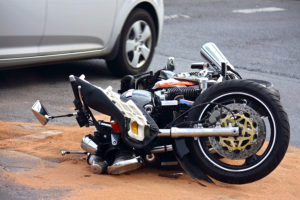
Why Do Cars Hit Motorcycles?
The main reason cars cause motorcycle accidents is that drivers don’t see the motorcycles. Most passenger vehicle drivers don’t also ride motorcycles. Therefore, they don’t know what it’s like to ride one alongside cars, and they aren’t watching for motorcycles. California has over 26 million licensed automobile drivers and less than a million licensed motorcycle riders. Given these numbers, motorcyclists know that they aren’t on the radar of most car and truck drivers.
Are Car Drivers Always Responsible For Motorcycle Accidents?
After a motorcycle accident, most people want to know who caused the crash. The reason is simple: the person responsible for causing the collision must pay for damages. Damages include repairing and replacing motorcycles and cars and any current and future costs associated with the accident. Medical bills, lost wages, and physical and psychological therapies are all considered damages. In addition, if an accident victim incurs any extra household or living expenses like in-home assistance or transportation services because of the crash, those are included in calculating damages. If a victim is found to have contributed to the accident or his injuries, the victim’s compensation can be reduced.
Accident scene evidence, witness accounts, motorcycle damage, and physical injuries all help answer the question of who caused a crash. Contributing factors include distracted driving, reduced visibility, road conditions, speed, and more. For motorcycle riders, attention will always be focused on what protective gear the riders wore at the time of the crash.
Contributory Negligence Means That More Than One Person Can Be At Fault In A Motorcycle Accident
California’s contributory negligence laws create several layers to the issue of who causes a motorcycle accident. When determining who pays for damages after a motorcycle accident, insurance companies or courts must answer these questions:
- Who caused the accident?
- Who contributed to causing the accident?
- Whose actions increased their damages?
These questions are particularly important for motorcyclists because many drivers and insurance companies think motorcycles are dangerous. Therefore, when a motorcyclist gets hurt, they look for reasons to blame the biker.
An experienced motorcycle accident attorney advocates for the victim after a wreck. My 35 years of representing motorcycle riders has taught me what to expect from insurance companies and automobile drivers after a wreck. I know how drivers will try to place blame on the motorcycle rider and how to respond effectively.
What If A Motorcycle Rider Does Not Wear A Helmet?
California is one of 19 states with a universal helmet law. This means that all motorcyclists, regardless of age and ability, must wear a helmet when riding.
Helmet Requirements
The helmet must be a U.S. Department of Transportation (DOT) compliant motorcycle helmet that fits the rider’s head securely. Some of the safety features required by the DOT include the following:
- An inner liner usually made of polystyrene foam and an inch thick
- Sturdy chin straps connected to the shell of the helmet with solid rivets
- Weighing at least three pounds
- No objects or features extending more than two-tenths of an inch from the shell of the helmet
California law requires a rider to wear a helmet on the rider’s head (not strapped to the bike). The chin straps must be securely fastened to prevent the helmet from moving around. Motorcycle passengers must also wear helmets meeting these requirements.
Consequences Of Not Wearing A Helmet
Motorcycle riders who violate the helmet law are subject to fines, and possibly probation. More importantly, failing to wear a helmet reduces compensation after a crash. In the personal injury world, violating a safety law equals negligence. An accident victim who violates a safety law is usually found partially at fault for the accident.
Sometimes an automobile driver who causes an accident has acted so egregiously that the driver’s fault dwarfs the motorcyclist’s fault. In those cases, the motorcyclist’s failure to wear a helmet may only lead to a small amount of fault being placed on the rider.
Sometimes the injuries a motorcycle rider sustains from a crash could not have been prevented by wearing a helmet. For contributory negligence to apply, the violated rule must have been designed to prevent the harm suffered. A helmet will not protect a rider against a broken leg, sprained wrist, or road rash on his limbs. If the motorcyclist’s head is not injured, the car driver’s argument of contributory negligence based on failure to wear a helmet should fail.
How A Long Beach Motorcycle Accident Attorney Can Help
Your Injuries Are Personal To Me
If you or a loved one has been injured in a motorcycle crash, an experienced motorcycle accident lawyer can help you obtain compensation for your losses. My personal injury law practice focuses only on victims. I know how most insurance companies view motorcycle accidents and I keep the blame focused on the driver who caused the wreck.
You deserve the maximum compensation you are entitled to. Your injuries are personal to me, so I handle every aspect of your case. I won’t stop fighting until you have received just compensation. Call the Law Office of Michael D. Waks at 888-394-1174. You can also use the convenient online contact form to schedule a free consultation.
You are under no obligation and you will never pay any money unless you recover damages for your injuries. I offer bilingual services and I am available 24/7 to talk to you about your case.
- How to Help Your Loved One Cope with a Spinal Cord Injury - October 27, 2021
- How Can I Prove a Motorist Fell Asleep in Traffic? - October 20, 2021
- Filing a Truck Accident Claim? Avoid These Common Mistakes - October 13, 2021